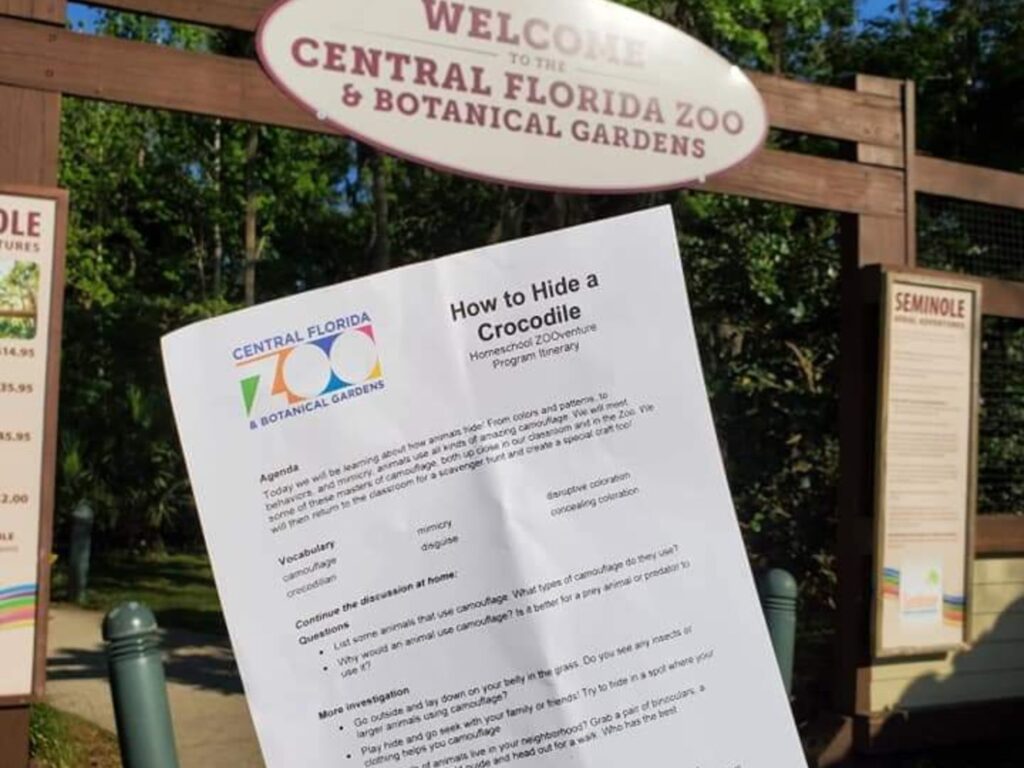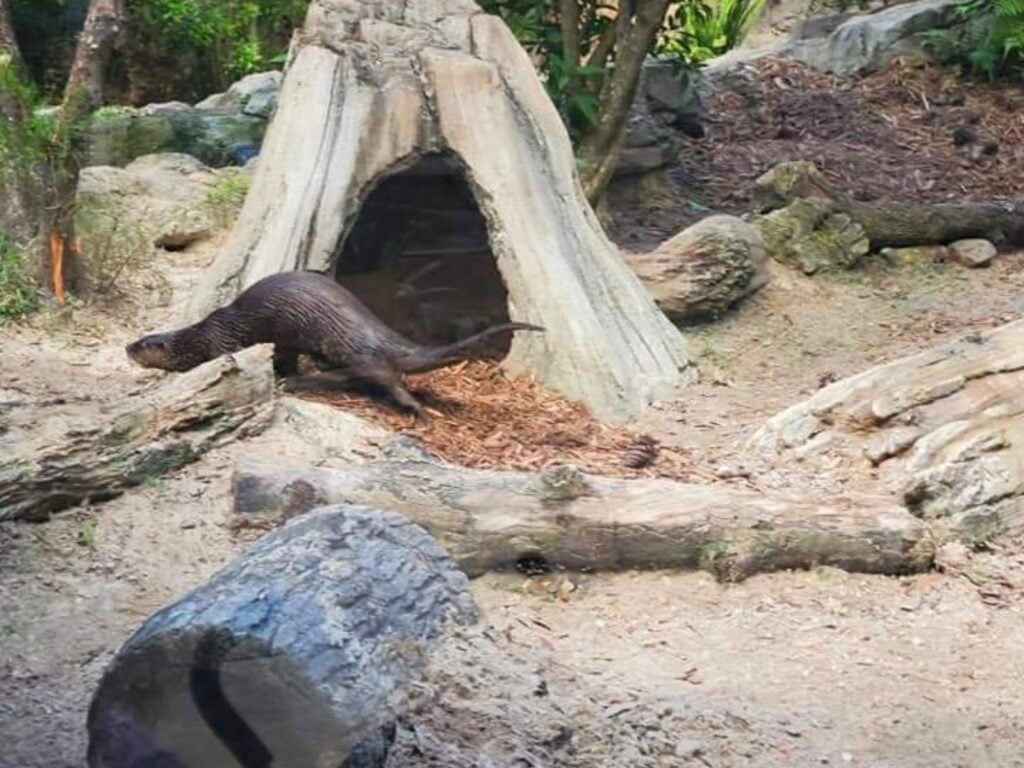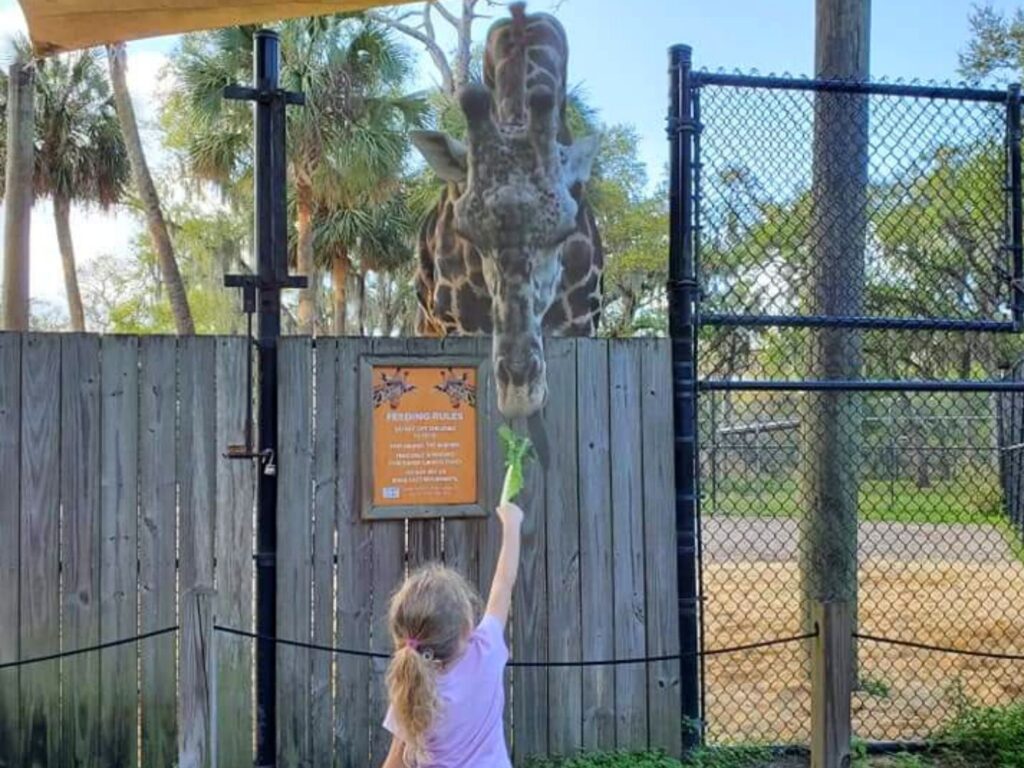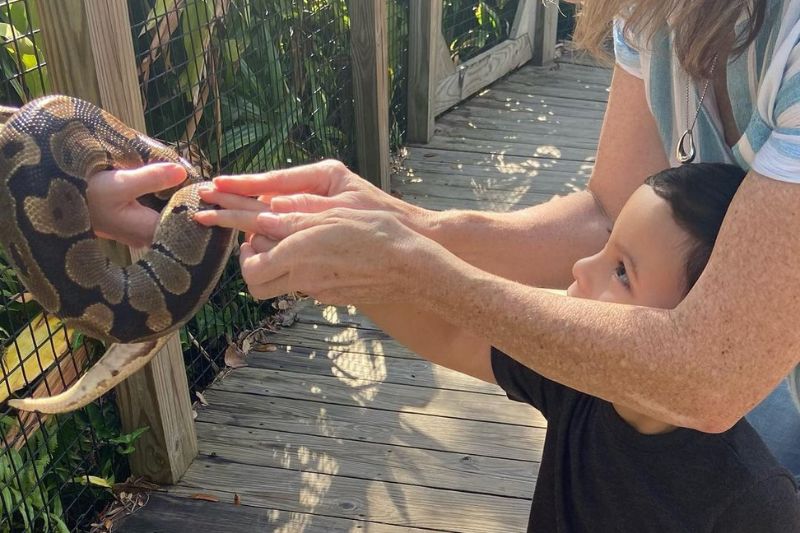Parent’s Ultimate Guide to Central Florida Zoo Homeschool Classes
Being outdoors and in nature has many benefits on children physically, mentally, and emotionally. Studies have proven that time in nature isn’t just a desire for some children but a necessity for all children according to this Harvard Health blog article. Of course, you parents who homeschool like me, we know this without needing studies to tell us because we see it before our eyes every day.
Maximize the power of nature and learning by enrolling in one of the Homeschool Programs at Central Florida Zoo & Botanical Gardens. We’re sharing our firsthand experiences and tips!
Zooventures
Every month from September to May homeschool families can bring classroom learning to life with interactive and up-close experiences through Zooventures.
Classes are affordable for homeschool families at $16.00 for annual passholders and $19.00 for non-passholders. I can attest the quality of learning content is worth the cost per class.
Classes are broken into the following age groups: 5-8 and 9-13. My oldest belongs in the first age group and has enjoyed attending Zooventures classes. Classes are from 2:00 p.m. – 4:00 p.m. on a Tuesday or Thursday afternoon typically during the second week of the month.
We usually arrive 15 minutes early for check in at the Wayne M. Densch Discovery Center located directly outside of the zoo gates.
Children do not need anything but a water bottle and face mask (for animal interaction only) to attend class unless otherwise noted specifically. Parents and guardians DO NOT attend class with the child. Let your baby bird soar from the nest!
This is where my younger two children and I would hop into the Zoo for independent learning for a couple of hours. It’s convenient that class ends and the zoo closes at 4:00 p.m.

Classes at Zooventures
Each year has brought new and different class content. The remainder of this school year will focus on:
Ages 5-8
- September 10 and 12, 2024: Creature Features
Meet creatures with amazing features! From the unusual to the extreme, these animals will surprise you with the strange adaptations they use to survive in the wild. - October 8 and 10, 2024: Calls in the Wild
Wouldn’t it be fun to chat with a cheetah or talk with a tiger? Listen and learn how animals communicate with each other. - November 12 and 14, 2024: I Dig Bones!
Get down and dirty in the Zoo’s paleontology dig site and examine fossils, skulls, and biofacts. Learn some cool facts about prehistoric animals and develop your skull skills as a junior paleontologist. - December 10 and 12, 2024: Winter Wildlife Wonders
Brrrr…It’s cold out there! How do animal survive and thrive in the cold winter weather? - January 14 and 16, 2025: Habitat Inhabitants
Animals are everywhere…trees, swamps, bogs, oceans, and more! Journey with us as we explore different animal habitats found around the world. - February 11 and 13, 2025: Ickyology
Enjoy the “yuk” side of animal science! Icky and gooey, slimy and slurpy, it’s a all about gross in this class! - March 11 and 13, 2025: Abracadabra!
Discover the magical things that animals can do! What makes a firefly glow? How does a caterpillar become a butterfly? Join us for magical mysteries of the animal world. - April 8 and 10, 2025: Dr. Zoo Little
Who can talk with the animals, walk with the animals, help all the animals? Dr. Zoo Little, that’s who! Learn about animal care at the Zoo. - May 13 and 15, 2025: Monkey Mayhem
Brachiation, prehensile, arboreal…what’s it all about? It’s all monkey mayhem as we have fun learning about primates!
Ages 9-13
- September 10 and 12, 2024: Rainforest Wonders
Through interactive activities, amazing biofacts, and live animals, students will be transported to the rainforests of the world. - October 8 and 10, 2024: Natures X-Men: Animal Mutations
What strange and unusual adaptations are lurking in the animal kingdom? We’ll seek out special animal mutations that can be used to hunt, hide and survive. - November 12 and 14, 2024: Primates of the Forest
From forests to rainforests, we’ll track primates around the world. Research and discovery will show us how we can help these incredible animals. - December 10 and 12, 2024: Island Seekers
It’s time to set sail in search of far off and mysterious islands where strange and unusual animals roam the forests and walk the beaches. - January 14 and 16, 2025: Fabulous Felines
Amazing and beautiful, felines roam the earth with grace and strength. We’ll explore their unique adapations and diversity. - February 11 and 13, 2025: Skull Skills
Take a fascinating look at skulls and other bones and learn what they can teach us about the animals they come from. - March 11 and 13, 2025: Buggin’ Out!
Explore the world of the mighty insect to discover how powerful these tiny giants can be. - April 8 and 10, 2025: Biodiversity Hotspot
What does it mean to be a global biodiversity hotspot? How can we help endemic species survive? Let’s find the answers! - May 13 and 15, 2025: Ultimate Sky Hunters
Raptors rule the sky looking for prey day and night. Powerful hunters and expert flyers, meet some of these incredible birds up close.
Students spend part of the time in a classroom setting and part of the time learning about their topic in the zoo. “How to Hide a Crocodile” was a homeschool class my son attended.
The first part of class was instruction on different animals who use camouflage in nature, both predators and prey. The students then took a class trip into the zoo to see animals who use camouflage and mimicry for survival.
For example, river otters are dark on top to blend with the murky river bottom when looking from above and a light silver on their underbelly to blend with the water when looking from below. At first glance, they can also resemble a log floating in the water.

The students observed this at the otter enclosure. Sometimes animals and insects are brought into the classroom for a closer look.
At 4:00, I arrived back at the Discovery Center to check my son out. Photo ID is required for pick up and the person picking a child up must be listed as an authorized person.
Parents are handed an envelope with a survey and the class agenda for that day during check out. The agenda is a wonderful resource to see what was discussed in class, how to continue the learning at home and for homeschool record-keeping purposes.
Family Workshops at Central Florida Zoo
For families looking to learn together, try one of the Family Workshops. These workshops are for families of every age and size. They also run from 2:00 p.m. – 4:00 p.m. Program cost is $32 per family for passholders or $37 per family for non-passholders.
Children and caregivers must attend together.
Volunteer at the Zoo
Don’t limit learning to the classroom though! Volunteer opportunities are available for youth ages 13-17. Students must complete an online request form to receive an application. Once the application is completed, the teen will be contacted for an interview. Teens selected will attend a three-day training program and must successfully pass a final exam. Teen volunteer schedules are on select Saturdays and Sundays.
High school students looking to earn volunteer hours for their Bright Futures Scholarship can apply to volunteer. Students will man activity stations for Zoo guests to learn more on animal topics. This volunteer position does not have any animal contact and solely interacts with Zoo guests.
Seize the opportunity to attend a remaining class before summer break. In doing so, you’ll have plenty of ideas to continue learning throughout the summer.

Central Florida Zoo & Botanical Gardens
3755 W. Seminole Blvd.
Sanford, Florida 32771
Phone: 407.323.4450 ext. 123
Email: education@centralfloridazoo.org
Feature image of Homeschool Programs at Central Florida Zoo from @centralflzoo

